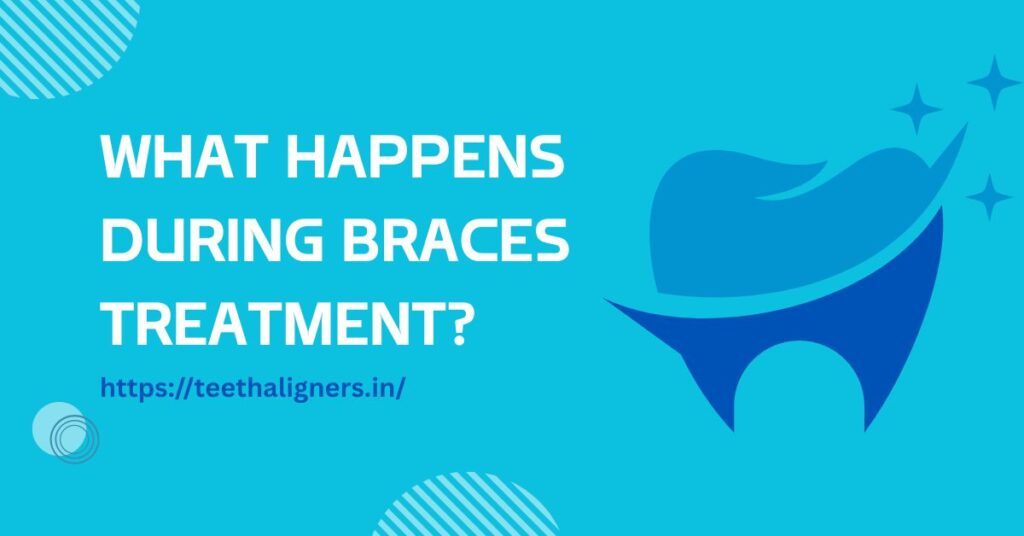A confident smile is one of the most powerful expressions a person can have. Straight teeth not only make your smile look attractive but also improve the overall health of your mouth. When teeth are properly aligned, it becomes easier to chew food, speak clearly, and keep your gums healthy.
Misaligned teeth, on the other hand, can cause uneven wear, jaw discomfort, and even cavities because cleaning becomes harder. That’s why many people consider orthodontic treatment with braces at some point in their lives. Yet, one of the biggest questions patients have is: what exactly happens during treatment?
The idea of wearing brackets and wires may sound overwhelming at first, but when the process is explained step by step, it becomes much less intimidating. This article will guide you through the entire journey, from the first consultation to the final day when you get to see your new smile.
Table of Contents
ToggleThe First Step – Consultation and Planning
Every orthodontic journey begins with a consultation. During this visit, the orthodontist takes time to study your mouth carefully. They look at your bite, check how your upper and lower teeth fit together, and examine whether there are gaps, crowding, or rotations.
Even small details are noted, since each tooth plays a role in how your smile comes together.Technology plays a big role at this stage. Photos, digital scans, and X-rays are often taken.
These images allow the orthodontist to see what lies beneath the gums, such as root positions and jawbone health. In some cases, impressions or molds are created using a soft material placed in trays.
These provide a three-dimensional model of your teeth, helping the orthodontist plan movements with accuracy, especially if you are considering advanced options like a 3D clear aligner for a discreet treatment.
After gathering all this information, the orthodontist sits down with you to explain the findings. They will outline how long the treatment is expected to take, what kinds of changes you might experience, and what your smile could look like at the end.
This is also the time to discuss costs and answer questions. Every plan is different, because no two sets of teeth are identical. Understanding the plan clearly makes patients feel more confident before the actual treatment begins.
Putting on the Braces
For most patients, the day the appliance is placed is both exciting and nerve-wracking. The process usually takes one to two hours, and it’s completely painless. It begins with a professional cleaning to make sure your teeth are free of plaque and ready for the brackets.
The orthodontist then applies a safe adhesive to each tooth and places the brackets carefully. Positioning is key, because even a small adjustment can affect how the teeth move later on. Once the brackets are secure, an archwire is threaded through them. Small elastic bands, often available in fun colors, hold the wire in place.
This archwire is the driving force of treatment. It applies steady, gentle pressure to guide the teeth into new positions. During this first appointment, patients often feel some tightness or pressure, but it’s not painful.
The mouth simply needs time to adapt. For the first few days, eating soft foods like mashed potatoes, soups, or rice is usually more comfortable. Drinking cold water can also help soothe sensitivity.
Adjustments and Monthly Visits
Getting the appliance placed is only the beginning. The real progress happens during the months that follow. Orthodontic treatment requires consistent monitoring, which is why regular adjustment appointments are scheduled.
These usually happen every four to six weeks, depending on the case.At each visit, the orthodontist may tighten the wires, replace them with stronger ones, or adjust the elastics.
Sometimes additional tools such as springs, power chains, or rubber bands are introduced to move teeth in specific ways. Each small change builds upon the last, guiding the teeth step by step into their ideal positions.
It’s normal to feel mild soreness for a day or two after adjustments. This happens because your teeth are responding to the pressure. Patients often describe it as a dull ache rather than sharp pain.
The good news is that it fades quickly, and every bit of progress is a reminder that the treatment is working.Watching the changes unfold is one of the most motivating parts of treatment. A tooth that was once twisted may start looking straighter.
Gaps that felt impossible to close began shrinking. Over time, the difference becomes noticeable, boosting patients’ confidence even before the appliance is removed.

Oral Care During Treatment
One of the most important responsibilities during treatment is maintaining good oral hygiene. Because brackets and wires create extra surfaces where food and plaque can stick, brushing and flossing require more effort.
Dentists recommend brushing after every meal, or at least three times a day, using a fluoride toothpaste. A soft-bristled toothbrush or an electric brush helps clean more effectively around brackets.
Special interdental brushes are useful for reaching tight spaces that a normal brush might miss.Flossing is equally important but slightly trickier.
Floss threaders allow you to slip floss behind the wires, while water flossers use a steady stream of water to clear out debris. Both methods help keep gums healthy and prevent cavities.
Diet adjustments are also part of oral care. Foods that are sticky, chewy, or very hard should be avoided. Items like caramel, popcorn, nuts, and chewing gum can break wires or dislodge brackets.
Softer foods like yogurt, bananas, and pasta are much safer and easier to eat, especially right after adjustments. Following these habits keeps your mouth healthy and prevents delays in the treatment timeline.
Managing Discomfort and Lifestyle Changes
It’s common to experience some discomfort at certain stages of treatment. The first few days after placement or adjustments can cause tenderness, but this is temporary. Over-the-counter pain relievers, cold compresses, and orthodontic wax all help manage discomfort.
Wax can be applied directly to brackets or wires that rub against the cheeks, preventing sores and irritation.Lifestyle adjustments also take place. At first, speaking may feel different, but most people adapt within a week.
Eating patterns change too, as softer foods are easier during the adjustment period. Sports players may need to wear a mouthguard to protect both the appliance and their lips during physical activity.
These changes can feel challenging in the beginning, but they quickly become part of daily life. In fact, most patients find that after a few weeks, wearing the appliance doesn’t interfere much with their routines at all.
Progress Monitoring and Results
Orthodontists don’t just place the appliance and wait. They actively monitor your progress through check-ups, X-rays, and digital scans. This allows them to track how the teeth are moving and make adjustments when needed.
Patients also play a major role in progress. Following instructions, wearing rubber bands as directed, and sticking to oral hygiene guidelines all make treatment smoother.
When patients cooperate, results are often achieved faster and more effectively.The most exciting part is seeing results unfold over time. Within a few months, noticeable differences appear.
Teeth look straighter, gaps close, and the bite begins to align properly. These changes are often enough to keep patients motivated throughout the journey, even during times when treatment feels long.
Removing the Braces
After months or even years of steady progress, the big day finally comes. Removal is quick and painless. The orthodontist gently loosens the brackets and wires, then removes the adhesive from the teeth.
Once the appliance is gone, your teeth are polished, leaving them smooth and shiny. Running your tongue across your teeth for the first time without brackets feels unusual but exciting.
Many patients describe this day as one of the happiest moments of the entire journey. It’s a celebration of patience, dedication, and the reward of a healthier, straighter smile.
The Role of Retainers After Treatment
Even after removal, the work isn’t over. Teeth naturally tend to shift back into their old positions, which is why retainers are so important. Retainers hold the teeth in place while the surrounding bone and tissues adapt to the new alignment.
There are two main types of retainers. Fixed retainers are thin wires bonded to the back of the teeth. They stay in place and require no effort other than normal cleaning.
Removable retainers, often made of clear plastic, can be taken out when eating or brushing.Your orthodontist will recommend which type is best for you, and how long you should wear them.
For most patients, wearing retainers full-time for the first few months is common, followed by nighttime use. Skipping this step risks undoing the progress, which is why it’s often said that retainers are just as important as the treatment itself.
Cost, Duration, and Location Factor
The duration of treatment varies depending on the complexity of the case. On average, it lasts between 18 and 24 months. Some patients complete treatment in as little as a year, while more complex cases may take three years.
Age, oral health, and how well patients follow instructions all play a role in timing.Cost also depends on several factors. The type of appliance used, treatment length, and orthodontist expertise all influence pricing.
Geographic location matters as well. For example, patients in Delhi may find that treatment costs differ compared to smaller towns because of access to advanced equipment and specialized care.
Choosing the right orthodontist is key. Clinics that combine technology with patient-centered care make the journey smoother. For example, practices like our clinic focus on guiding patients through every stage with clarity and support, making treatment less stressful and more rewarding.
Conclusion
Braces treatment is a detailed but rewarding process. It begins with careful planning, continues through adjustments and daily care, and ends with a confident smile that can last a lifetime.
Each stage has its own role, from consultation and placement to adjustments, removal, and retainers. Along the way, patients experience both challenges and milestones, but the end result is worth every step.
If you’ve ever considered orthodontic treatment, remember that the journey is temporary, but the benefits last forever. A straighter smile improves oral health, boosts confidence, and can positively impact many aspects of life.
Clinics like Teeth Aligners in India provide expert care and guidance to make this journey smoother, helping patients achieve the healthy and beautiful smile they’ve always wanted.

